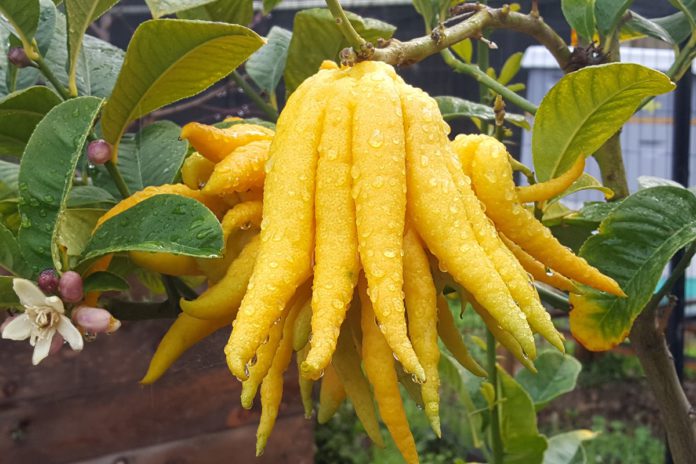The world is a smaller place today for many reasons. Commercial jets can get you halfway around the globe in less than a day. Cell phone apps allow people to see and talk to friends and family all over the world in real time. Ethnic grocery stores provide a way to sample foods from their respective countries or regions. Nurseries bring different parts of the world closer by selling exotic plants such as unusual citrus tree varieties. Each has their own characteristics that can make it worth growing in the Bay Area.
The care and growing conditions of exotic citrus varieties are identical to those of common varieties. They can be planted in the ground or grown in an indoor or outdoor container. They require a warm, sunny location and will need to be protected from frost in the winter. Pruning should be done in early spring just after the last frost and before new growth appears. They should be fed with an organic citrus fertilizer or compost when deemed necessary by experienced gardeners, or about every three to four months if placed on a fertilizing schedule. They should be watered when the top two inches of soil feels dry.
Procuring an unfamiliar citrus tree takes a little more effort than purchasing a common variety. Although local nurseries may not have them in stock, they may be able to make a special order from their wholesale grower. Four Winds Growers, fourwindsgrowers.com, located in Watsonville, sells a variety of exotic citrus trees online. Another option for growing unfamiliar citrus fruits is to graft a few small branches or whips from an exotic citrus tree onto an existing citrus tree. The grafted branches will eventually produce their own fruit variety while the rest of the tree continues to produce its original variety.
Citrus trees are native to northeastern and central Australia, subtropical and tropical regions of Asia, Maritime Southeast Asia and Near Oceania. There are many unique varieties and cultivars within this large diverse area. Below are six lesser-known citrus trees from these regions that are much different to ones commonly grown in the Bay Area.
Calamansi: Also known as calamondin, Philippine lime, or acid orange. It is a tree that produces small, sweet-and-sour tasting fruit which is a hybrid between a kumquat and mandarin orange. It is ubiquitous in Filipino cuisine and is also a common ingredient found in Malaysian and Indonesian dishes. It is also eaten raw or squeezed into cocktails, over raw oysters or other types of seafood.
Yuzu: This small, thorny tree produces a very aromatic fruit that is used throughout Asia and extensively in Japan and South Korea. Yuzu varieties are used much the same way in these two countries as lemons are used in North American cooking. Both the zest and the juice are incorporated into main dishes, desserts, marmalades, teas, alcohol infusions, rice wines and vinegars. Yuzu fruit is rarely eaten raw. It can also be cut in half and floated in bath water for its fragrance.
Buddha’s Hand: Unlike other citrus fruits, Buddha’s Hand fruit is solid and does not have any pulp or juice. It does, however, have a strong fragrance resembling violets or osmanthus flowers making the zest useful in cuisine and alcoholic beverages, as well as scenting rooms and clothing. The segmented “finger” sections of the yellow fruit also make Buddha’s Hand an alluring ornamental addition to the garden.
Key lime: This Southeast Asian lime is strongly associated with the Florida Keys in the U.S. Outside of the U.S., it is known as the West Indian lime or the Omani lime. The fruit is sought out for its aroma and its distinctive sweet taste. The zest and the juice from the fruit are primarily used in desserts, beer and in non-alcohol/alcohol mixers in the US. The juice and zest are incorporated into noodle and curry dishes in Asian countries.
Thai lime: Also called Makrut lime, it is probably best known as Kaffir lime. However, the word Kaffir, now referred to in South Africa as the K-word, is a derogatory ethnic slur, and there is a movement in the horticultural world not to use that name anymore. The aromatic Thai lime fruit and leaves are widely used in Thai, Indonesian and other Southeast Asian cuisines.
Finger lime: The finger shape of this native Australian citrus sets this lime apart from the round and oval shapes of most other citrus fruits. However, that is not its most special characteristic. Instead, it is the globular juice pearls that make up the flesh. Often referred to as “lime caviar,” the juice vesicles burst with lime flavor when eaten on oysters, seafood or appetizers complemented by this fresh flavor. The fragrant fruit is also used in many Asian dishes as a lemongrass substitute.
There are many other interesting types of citrus trees grown throughout Asia and Oceania. Unfortunately, many of the fruits cannot be imported because of disease and insect abatement. However, you can still experience these exotic fruits from halfway around the world, by purchasing the whole plant locally and growing them yourself.
Daniel O’Donnell is the co-owner and operator of an organic landscape design/build company in Fremont. www.Chrysalis-Gardens.com




